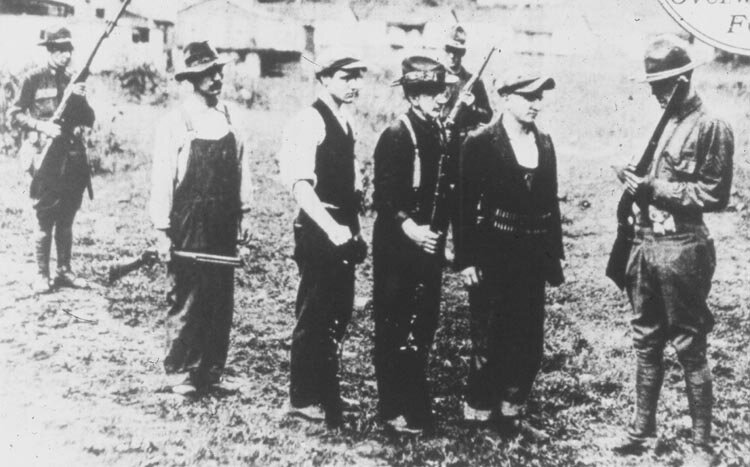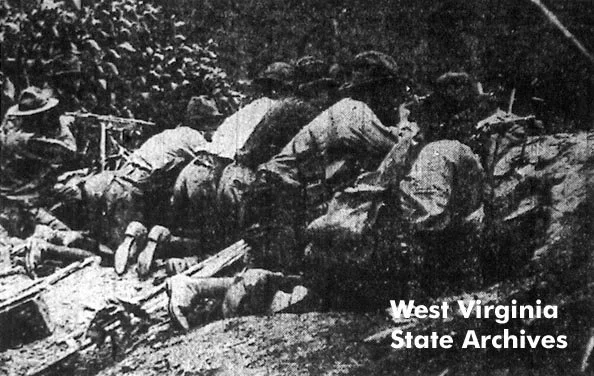This Month in W.Va. History: The Battle of Blair Mountain and The Impact It Left
Back in May, we highlighted the Matewan Massacre and how it helped spark a series of events that have become part of West Virginia’s DNA. As promised, we’re now going to take a look at those events.
Picking up where we left off in May, Sid Hatfield and his associate Ed Chambers were gunned down by Baldwin-Felts agents, who were initially brought in to break up mine strikes and had previously clashed with Hatfield’s men in Matewan.
The murder unintentially spurred more union activity and was the spark that led to the Battle of Blair Mountain. Union miners from southern counties across the state organized a march to Mingo County with the goal of freeing miners who’d been jailed under martial law and organizing a union there by force.
To get a better sense of the situation at the time, miners almost always worked in horrible conditions and were beholden to mine companies. They were often paid with company money that was only good at the company store. Unions were a way of making sure they had rights and that their voices were being heard, especially in counties like Logan and Mingo, where there was no union at the time.
So in the wake of Hatfield’s murder with plans of a march brewing, United Mine Workers leaders Frank Keeney and Fred Mooney met with then-Gov. Ephraim Morgan with a list of demands, which the governor rejected. The governor also warned that if the march continued, the miners would face treason charges. At this point, some ended their march, but when news spread that a group of miners were raided and two killed by state police in Logan County, the movement regained steam.
At least 5,000 miners, many donning red bandanas (more on this in a bit), began the march for Mingo County. To get there, they would have to cross through Logan County and over Blair Mountain where sheriff Don Chafin and a few thousand men under the command of Col. William Eubank were waiting. Chafin, an anti-union sheriff, did not have a large sheriff’s office, but he was supported by local civilians and coal operators who gave him and Eubank a 2,000 man army to battle the marchers.
You may think “the miners have at least twice as many men, they got this,” but what the miners didn’t have was good position. While the miners set up at the base of Blair Mountain, Eubank, Chafin and their men positioned themselves on the ridgeline. It doesn’t take a military tactics genius to know that’s not ideal if you’re the miners, no matter how many men you have.
Not long after the miners arrived in Blair, gunfire erupted on the mountainside after a small group of miners out on patrol ran into three of Chafin’s deputies. For three days, the two sides relentlessly fired rounds at each other. Armed with a strategic positional advantage on the ridgeline, the anti-union militia also had firepower with machine guns and even homemade gas and explosive bombs that were dropped out of private planes.
After several days of fighting and the miners beginning to make a push through the battle lines, federal troops were dispatched to break up the fighting. Most of the miners, some of whom were also veterans, agreed not to fire on the troops and either left or were jailed.
On Sept. 4, 1921, the mine wars ended. There’s no definite number how many were killed on Blair Mountain. Hundreds of miners were indicted on various charges and most were acquitted. Others were jailed before being pardoned or paroled. Union membership plummeted during the next decade before rebounding following the Great Depression and beginning of the New Deal.
Despite the apparent loss, the miners’ willingness to take up arms for their rights left an indelible mark on the coal industry and the nation. The solidarity and defiance of the men in the red bandanas, or the Red Neck Army, during the conflict helped highlight their struggles in front of a national audience and eventually helped strengthen the union’s stance years later.
So, while the term “redneck” might be thrown around in a negative context nowadays, try to remember that its roots stem from something you can be proud of: a fight for justice, representation and rights -- a fight that still continues today in many ways.


